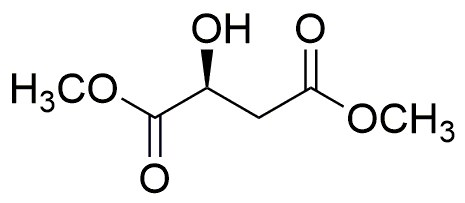Dimethyl (S)-(-)-malate is widely utilized in research focused on:
- Flavoring and Fragrance Industry: This compound is used as a flavor enhancer in food products, providing a fruity taste that is appealing in beverages and confections.
- Pharmaceutical Applications: It serves as an intermediate in the synthesis of various pharmaceuticals, aiding in the development of drugs that target metabolic disorders.
- Biochemical Research: Researchers use it to study metabolic pathways, particularly in relation to energy production and amino acid metabolism, enhancing our understanding of cellular processes.
- Agricultural Sector: It can be utilized in the formulation of biopesticides and fertilizers, promoting plant growth and improving crop yields through its role in metabolic enhancement.
- Cosmetic Formulations: The compound is incorporated into skincare products for its moisturizing properties, contributing to improved skin texture and hydration.
General Information
Properties
Safety and Regulations
Applications
Dimethyl (S)-(-)-malate is widely utilized in research focused on:
- Flavoring and Fragrance Industry: This compound is used as a flavor enhancer in food products, providing a fruity taste that is appealing in beverages and confections.
- Pharmaceutical Applications: It serves as an intermediate in the synthesis of various pharmaceuticals, aiding in the development of drugs that target metabolic disorders.
- Biochemical Research: Researchers use it to study metabolic pathways, particularly in relation to energy production and amino acid metabolism, enhancing our understanding of cellular processes.
- Agricultural Sector: It can be utilized in the formulation of biopesticides and fertilizers, promoting plant growth and improving crop yields through its role in metabolic enhancement.
- Cosmetic Formulations: The compound is incorporated into skincare products for its moisturizing properties, contributing to improved skin texture and hydration.
Documents
Safety Data Sheets (SDS)
The SDS provides comprehensive safety information on handling, storage, and disposal of the product.
Product Specification (PS)
The PS provides a comprehensive breakdown of the product’s properties, including chemical composition, physical state, purity, and storage requirements. It also details acceptable quality ranges and the product's intended applications.
Certificates of Analysis (COA)
Search for Certificates of Analysis (COA) by entering the products Lot Number. Lot and Batch Numbers can be found on a product’s label following the words ‘Lot’ or ‘Batch’.
*Catalog Number
*Lot Number
Certificates Of Origin (COO)
This COO confirms the country where the product was manufactured, and also details the materials and components used in it and whether it is derived from natural, synthetic, or other specific sources. This certificate may be required for customs, trade, and regulatory compliance.
*Catalog Number
*Lot Number
Safety Data Sheets (SDS)
The SDS provides comprehensive safety information on handling, storage, and disposal of the product.
DownloadProduct Specification (PS)
The PS provides a comprehensive breakdown of the product’s properties, including chemical composition, physical state, purity, and storage requirements. It also details acceptable quality ranges and the product's intended applications.
DownloadCertificates of Analysis (COA)
Search for Certificates of Analysis (COA) by entering the products Lot Number. Lot and Batch Numbers can be found on a product’s label following the words ‘Lot’ or ‘Batch’.
*Catalog Number
*Lot Number
Certificates Of Origin (COO)
This COO confirms the country where the product was manufactured, and also details the materials and components used in it and whether it is derived from natural, synthetic, or other specific sources. This certificate may be required for customs, trade, and regulatory compliance.

